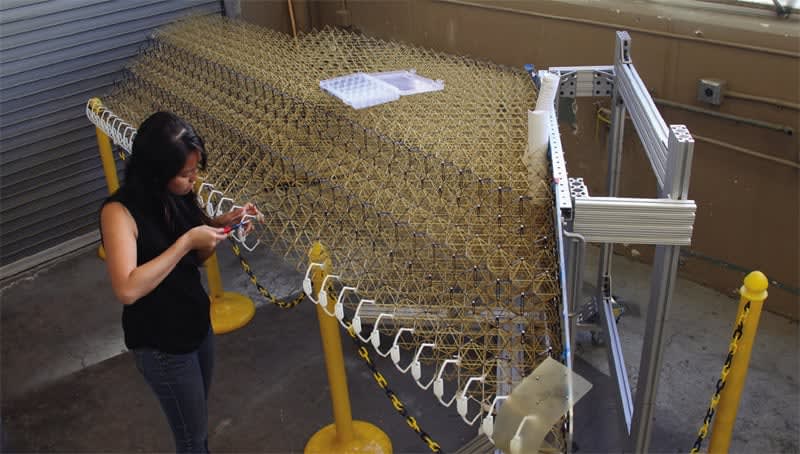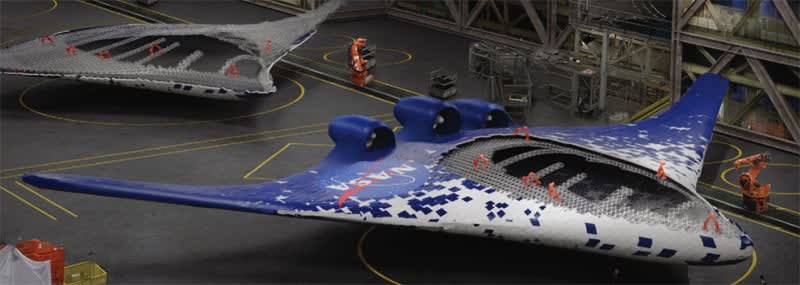A radically new kind of airplane wing, assembled from hundreds of tiny identical pieces, can change shape to control the plane’s flight, and could provide a significant boost in aircraft production, flight, and maintenance efficiency. The new approach to wing construction could afford greater flexibility in the design and manufacturing of future aircraft.

Instead of requiring separate movable surfaces, such as ailerons, to control the roll and pitch of the plane as conventional wings do, the new assembly system makes it possible to deform the whole wing or parts of it by incorporating a mix of stiff and flexible components in its structure. The tiny subassemblies — which are bolted together to form an open, lightweight lattice framework — are then covered with a thin layer of similar polymer material as the framework.
The result is a wing that is much lighter, and thus much more energy-efficient than those with conventional designs, whether made from metal or composites. Because the structure, comprising thousands of tiny triangles of matchstick-like struts, is composed mostly of empty space, it forms a mechanical “metamaterial” that combines the structural stiffness of a rubberlike polymer and the extreme lightness and low density of an aerogel.
For each of the phases of a flight — takeoff and landing, cruising, maneuvering, and so on — each has its own different set of optimal wing parameters, so a conventional wing is necessarily a compromise that is not optimized for any of these, and therefore sacrifices efficiency. A wing that is constantly deformable could provide a much better approximation of the best configuration for each stage.

While it would be possible to include motors and cables to produce the forces needed to deform the wings, the team has taken this a step further and designed a system that automatically responds to changes in its aerodynamic loading conditions by shifting its shape — a sort of self-adjusting, passive wing-reconfiguration process. This is accomplished by the careful design of the relative positions of struts with different amounts of flexibility or stiffness designed so that the wing, or sections of it, bend in specific ways in response to particular kinds of stresses.
While this version of the wing was hand-assembled, the repetitive process is designed to be easily accomplished by a swarm of small, simple, autonomous assembly robots.
The individual parts for the wing were cut using a waterjet system, and it took several minutes to make each part. The new system uses injection molding with polyethylene resin in a complex 3D mold and produces each part — essentially a hollow cube made up of matchstick-size struts along each edge — in just 17 seconds, which brings it a long way closer to scalable production levels. The resulting lattice has a density of 5.6 kilograms per cubic meter. By way of comparison, rubber has a density of about 1,500 kilograms per cubic meter.
Because the overall configuration of the wing or other structure is built up from tiny subunits, the shape doesn’t matter. The fact that most aircraft are the same shape — essentially a tube with wings — is because of expense, not efficiency. Massive investments in design, tooling, and production processes make it easier to stay with long-established configurations. An integrated body and wing structure could be far more efficient for many applications and with this system, those could be easily built, tested, modified, and retested.
The new wing was designed to be as large as could be accommodated in NASA’s high-speed wind tunnel at Langley Research Center, where it performed even a bit better than predicted. The same system could be used to make other structures as well including the wing-like blades of wind turbines, where the ability to do on-site assembly could avoid the problems of transporting ever-longer blades. Similar assemblies are being developed to build space structures and could eventually be useful for bridges and other high-performance structures.
For more information, contact Karl-Lydie Jean-Baptiste at

